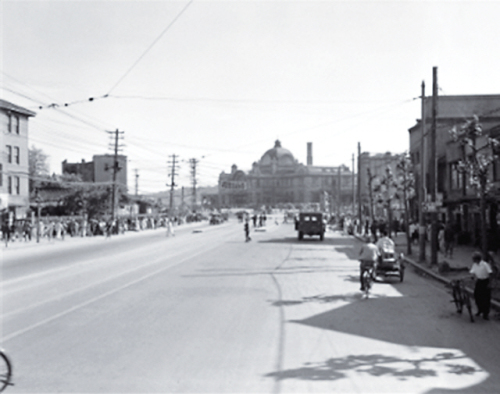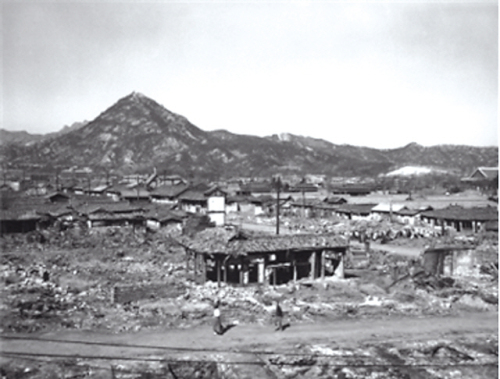Seoul’s turbulent times captured by foreign lenses
By Lee Woo-youngPublished : May 20, 2012 - 19:37
Photo exhibition gives views of the capital from colonial times to 1960
Photos showcasing the most turbulent times in modern Korea are on public display at Seoul Museum of History.
The photo exhibition “Seoul in Turbulence: As Seen by the AP” features vivid images taken by the Associated Press during the tumultuous days of Japanese colonial rule and the Korean War to the April 19 revolution, the nation’s first upheaval for democracy.
While government censorship was imposed on domestic media, the foreign news agency was able to capture the ruins of the capital during the war, as well as everyday life and the social dynamics once the war ended.
The photographers who braved the battlefields were Max Desfor, Leif Erickson, Frank Noel, Don Whitehead and Hal Boyle. Of them, Desfor won a Pulitzer Prize in 1951 for his photograph capturing the flight of refugees across a bombed bridge during the Korean War. Noel was captured by Chinese forces in November 1950 and sent to prison camps. He was freed three years later in an exchange of prisoners when the war ended.
Photos showcasing the most turbulent times in modern Korea are on public display at Seoul Museum of History.
The photo exhibition “Seoul in Turbulence: As Seen by the AP” features vivid images taken by the Associated Press during the tumultuous days of Japanese colonial rule and the Korean War to the April 19 revolution, the nation’s first upheaval for democracy.
While government censorship was imposed on domestic media, the foreign news agency was able to capture the ruins of the capital during the war, as well as everyday life and the social dynamics once the war ended.
The photographers who braved the battlefields were Max Desfor, Leif Erickson, Frank Noel, Don Whitehead and Hal Boyle. Of them, Desfor won a Pulitzer Prize in 1951 for his photograph capturing the flight of refugees across a bombed bridge during the Korean War. Noel was captured by Chinese forces in November 1950 and sent to prison camps. He was freed three years later in an exchange of prisoners when the war ended.


The selection of photos provides the opportunity to see how the capital’s landmarks such as Seoul Station, Seoul Plaza and Cheonggyecheon have changed over time.
The view of the bustling street from Sungnyemun to Seoul Station reflects the population increase from 1945-47 when the population grew from 900,000 to 1.6 million.
Other pictures showing the Cheonggyecheon and the panoramic view of Seoul from Namsan will give viewers an idea of how the capital developed and what it looked like before the war.
But the comparison becomes stark when the capital turns into war-torn ruins in 1950 as shown in the photo of ruined Jongno. According to the exhibition description, more than half of central Seoul was damaged by the war.
The frustration and instability that ordinary citizens might have felt during the conflict is clearly seen in the photo in which children and mothers sitting in a group using their hands to insulate their ears from the sound of gunfire.
But life went on, as some photos show citizens selling and buying at an open air market and women washing clothes in the street where nothing left but burned trees and walls.
A photo capturing a woman smiling while organizing things at her makeshift shop in a destroyed building gives a sense of hope in the middle of ruins.
After the armistice agreement was signed in 1953, full-scale reconstruction efforts started across the city. A photo shows men and women collecting bricks from war remains to construct new buildings.
Photos taken after the war show the social conflicts resulting from ideological disputes and the fight for democracy.
The exhibition ends the turbulent days of Korea’s modern history with a photo depicting citizens’ marching through streets demanding President Syngman Rhee step down after a rigged presidential election in March 1960 and citizens walking through central Seoul peacefully.
The exhibition is open to the public free of charge and runs till June 3 at Seoul Museum of History.
By Lee Woo-young (wylee@heraldcorp.com)
















![[KH Explains] Hyundai's full hybrid edge to pay off amid slow transition to pure EVs](http://res.heraldm.com/phpwas/restmb_idxmake.php?idx=652&simg=/content/image/2024/04/18/20240418050645_0.jpg&u=20240418181020)

![[Today’s K-pop] Zico drops snippet of collaboration with Jennie](http://res.heraldm.com/phpwas/restmb_idxmake.php?idx=642&simg=/content/image/2024/04/18/20240418050702_0.jpg&u=)